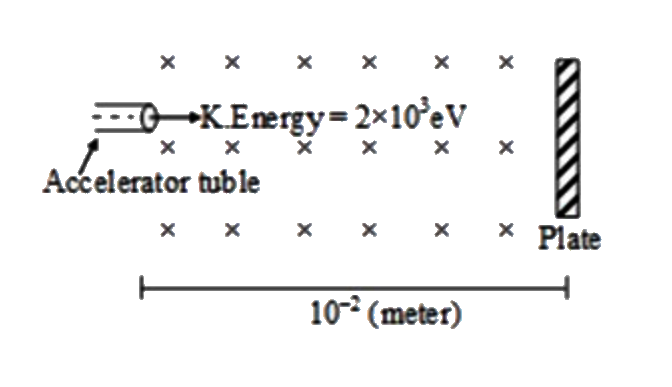The charge on α particle is ………The charge on proton
To determine the charge on an alpha particle in relation to the charge on a proton, follow these steps:
Step 1: Understand the Composition of an Alpha Particle
An alpha particle is essentially the nucleus of a helium atom. It consists of 2 protons and 2 neutrons.
Step 2: Determine the Charge of a Proton
The charge of a single proton is +1 elementary charge (approximately +1.6 x 10^-19 coulombs).
Step 3: Calculate the Charge of an Alpha Particle
Since an alpha particle contains 2 protons, its total charge can be calculated as follows:
- Charge of an alpha particle = Charge of 2 protons
- Charge of an alpha particle = 2 x (+1) = +2 elementary charges.
Step 4: Compare the Charges
Now, we can compare the charge of the alpha particle to the charge of a proton:
- Charge of alpha particle = +2
- Charge of proton = +1
Conclusion
Thus, the charge on an alpha particle is twice the charge on a proton.
Final Answer: The charge on an alpha particle is twice the charge on a proton.
---
An alpha particle is essentially the nucleus of a helium atom. It consists of 2 protons and 2 neutrons.
The charge of a single proton is +1 elementary charge (approximately +1.6 x 10^-19 coulombs).
Since an alpha particle contains 2 protons, its total charge can be calculated as follows:
- Charge of an alpha particle = Charge of 2 protons
- Charge of an alpha particle = 2 x (+1) = +2 elementary charges.
Now, we can compare the charge of the alpha particle to the charge of a proton:
- Charge of alpha particle = +2
- Charge of proton = +1
Thus, the charge on an alpha particle is twice the charge on a proton.
Topper's Solved these Questions
- BOOK - CENGAGE CHEMISTRY ENGLISHCHAPTER - ATOMIC STRUCTUREEXERCISE - Exercises True And False30videos
ATOMIC STRUCTURE
- BOOK - CENGAGE CHEMISTRY ENGLISHCHAPTER - ATOMIC STRUCTUREEXERCISE - Archives (Linked Comprehension3videos
ATOMIC STRUCTURE
- BOOK - CENGAGE CHEMISTRY ENGLISHCHAPTER - ATOMIC STRUCTUREEXERCISE - Exercises Integer11videos
ATOMIC STRUCTURE
- BOOK - CENGAGE CHEMISTRY ENGLISHCHAPTER - APPENDIX - INORGANIC VOLUME 1EXERCISE - chapter-7 Single correct answer1videos
APPENDIX - INORGANIC VOLUME 1
- BOOK - CENGAGE CHEMISTRY ENGLISHCHAPTER - CHEMICAL BONDING AND MOLECULAR STRUCTUREEXERCISE - Archives Subjective15videos
CHEMICAL BONDING AND MOLECULAR STRUCTURE
Similar Questions
Assertion (A):β− particles are deflected more than α− particles in a given electric field.
Reason (R):Charge on α− particles is larger than on β−particles.View SolutionA fusion reaction consists of combining four protons into an α–particle. The mass of α–particle is 4.002603u and that of proton is 1.007825u, mass of electron is 0.00054466u.
View Solution
Knowledge Check
- Question 1 - Select One
Assertion : During α -particles scattering experiment, 99% of the α-particles get deflected through very large angles.
Reason : The nuclei of atoms are positively charged and repel α-particles which are also positively charged.AIf both Assertion and Reason are correct and Reason is the correct explanation of Assertion.BIf both Assertion and Reason are correct and Reason is not the correct explanation of Assertion.CIf Assertion is correct but Reason is incorrect.DIf Assertion is incorrect but Reason is correct.
A charged particle having a mass of 1.6×10−26kg comes out of accelerator tube with kinetic energy 2×103eV . Calculate the smallest magnitude of the magnetic field that should be applied in vertically downwards direction to just prevent the charged particle from colliding the plate (Assume charge on particle = charge of the proton)
 View Solution
View SolutionThe charge to mass ratio of α− particles is approximately to the charge to mass ratio of protons:
View SolutionState (a) the mass (b) charge on :
protonView SolutionIf an alpha particle, proton and deuteron are projected perpendicularly a uniform magnetic field with same speed then let rα is the radius of α-particles, rP is radius of proton, rd is radius of deuteron.
View SolutionStatement 1: If a proton and an α-particle enter a uniform magnetic field perpendicularly with the same speed, the time period of revolution of α-particle is double than that of proton.
Statement 2: In a magnetic field, the period of revolution of a charged particle is directly proportional to the mass of the particle and inversely proprotional to the charge of particle.View SolutionStatement 1: If a proton and an α-particle enter a uniform magnetic field perpendicularly with the same speed, the time period of revolution of α-particle is double than that of proton.
Statement 2: In a magnetic field, the period of revolution of a charged particle is directly proportional to the mass of the particle and inversely proprotional to the charge of particle.View SolutionAlpha particles are positively charged.
View Solution

